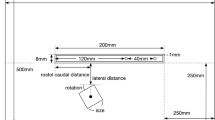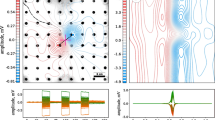Abstract
The weakly electric fish have a specialized sensor system of electrolocation. They use the electric field to identify the location of a target object. When the object is near the electric fish, the distortion of electric field is observed and this distortion draws a bell-shaped curve along electroreceptors on the whole surface of weakly electric fish. The ratio of maximal slope to maximal amplitude in this electric image is called relative slope. It is already known that the relative slope can be a distance measure of a target object. However, if there are more than one object, a bell-shaped electric image for each object is superposed. So it is difficult to extract the relative slope information for each object. It means that the location of each target object can hardly be estimated among background objects. In this paper, we provide a new mechanism to figure out the position of a target object, based on the spatiotemporal information of electrosenses.
Access this chapter
Tax calculation will be finalised at checkout
Purchases are for personal use only
Preview
Unable to display preview. Download preview PDF.
Similar content being viewed by others
References
MacIver, M.: The computational neuroethology of weakly electric fish: body modeling, motion analysis, and sensory signal estimation. PhD thesis, University of Illinois (2001)
von der Emde, G., Schwarz, S., Gomez, L., Budelli, R., Grant, K.: Electric fish measure distance in the dark. Nature 395, 890–894 (1998)
von der Emde, G.: Active electrolocation of objects in weakly electric fish. Journal of Experimental Biology 202(10), 1205–1215 (1999)
Schwarz, S., von der Emde, G.: Distance discrimination during active electrolocation in the weakly electric fish Gnathonemus petersii. Journal of Comparative Physiology A: Neuroethology, Sensory, Neural, and Behavioral Physiology 186(12), 1185–1197 (2001)
Sicardi, E., Caputi, A., Budelli, R.: Physical basis of distance discrimination in weakly electric fish. Physica A: Statistical Mechanics and its Applications 283(1-2), 86–93 (2000)
Chen, L., House, J., Krahe, R., Nelson, M.: Modeling signal and background components of electrosensory scenes. Journal of Comparative Physiology A: Sensory, Neural, and Behavioral Physiology 191(4), 331–345 (2005)
Lannoo, M., Lannoo, S.: Why do electric fishes swim backwards? An hypothesis based on gymnotiform foraging behavior interpreted through sensory constraints. Environmental Biology of Fishes 36(2), 157–165 (1993)
Lissmann, H., Machin, K.: The mechanism of object location in Gymnarchus niloticus and similar fish. Journal of Experimental Biology 35(2), 451–486 (1958)
Kramer, B.: Electroreception and communication in fishes. Gustav Fischer (1996)
Rasnow, B.: The effects of simple objects on the electric field of Apteronotus. Journal of Comparative Physiology A: Neuroethology, Sensory, Neural, and Behavioral Physiology 178(3), 397–411 (1996)
Heiligenberg, W.: Theoretical and experimental approaches to spatial aspects of electrolocation. Journal of Comparative Physiology A: Neuroethology, Sensory, Neural, and Behavioral Physiology 103(3), 247–272 (1975)
Budelli, R., Caputi, A., Gomez, L., Rother, D., Grant, K.: The electric image in Gnathonemus petersii. Journal of Physiology-Paris 96(5-6), 421–429 (2002)
Author information
Authors and Affiliations
Editor information
Editors and Affiliations
Rights and permissions
Copyright information
© 2010 Springer-Verlag Berlin Heidelberg
About this paper
Cite this paper
Sim, M., Kim, D. (2010). Estimating Relative Positions of Multiple Objects in the Weakly Electric Fish. In: Doncieux, S., Girard, B., Guillot, A., Hallam, J., Meyer, JA., Mouret, JB. (eds) From Animals to Animats 11. SAB 2010. Lecture Notes in Computer Science(), vol 6226. Springer, Berlin, Heidelberg. https://doi.org/10.1007/978-3-642-15193-4_20
Download citation
DOI: https://doi.org/10.1007/978-3-642-15193-4_20
Publisher Name: Springer, Berlin, Heidelberg
Print ISBN: 978-3-642-15192-7
Online ISBN: 978-3-642-15193-4
eBook Packages: Computer ScienceComputer Science (R0)





